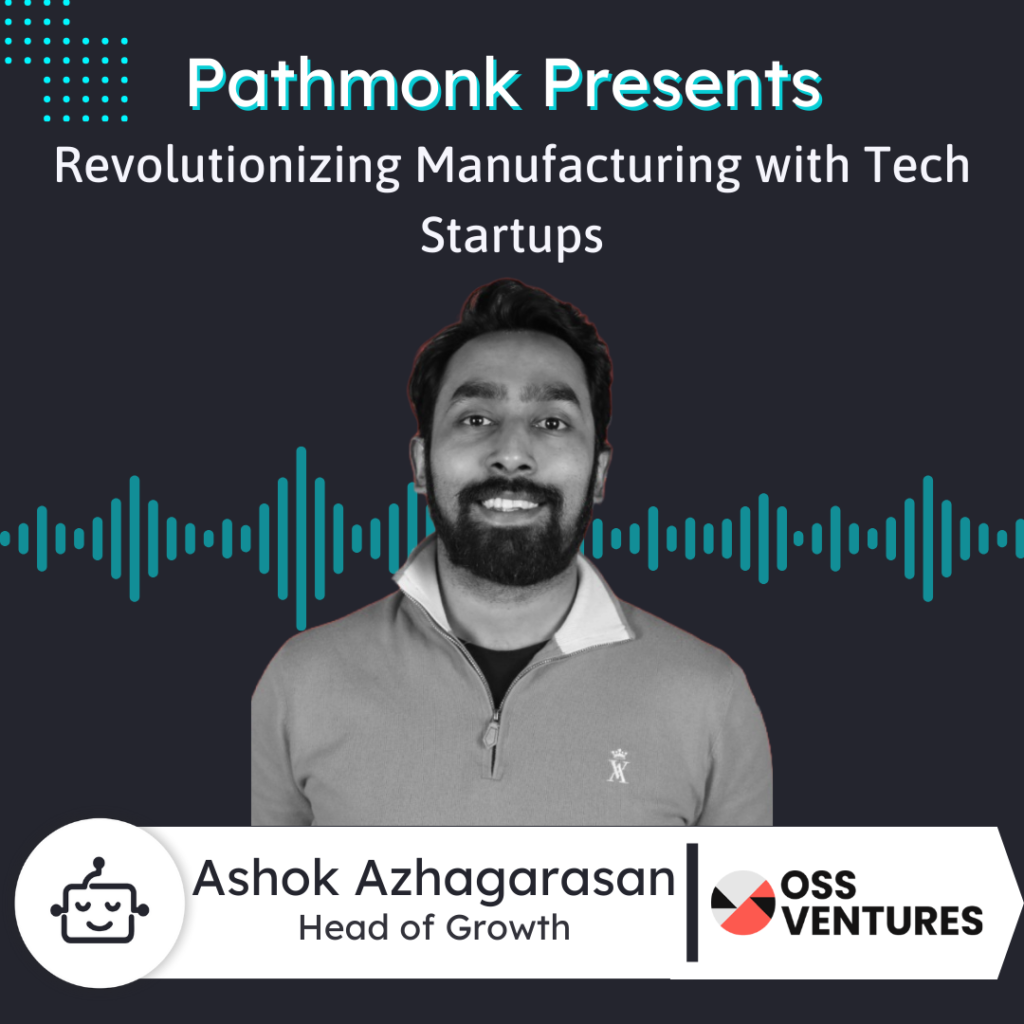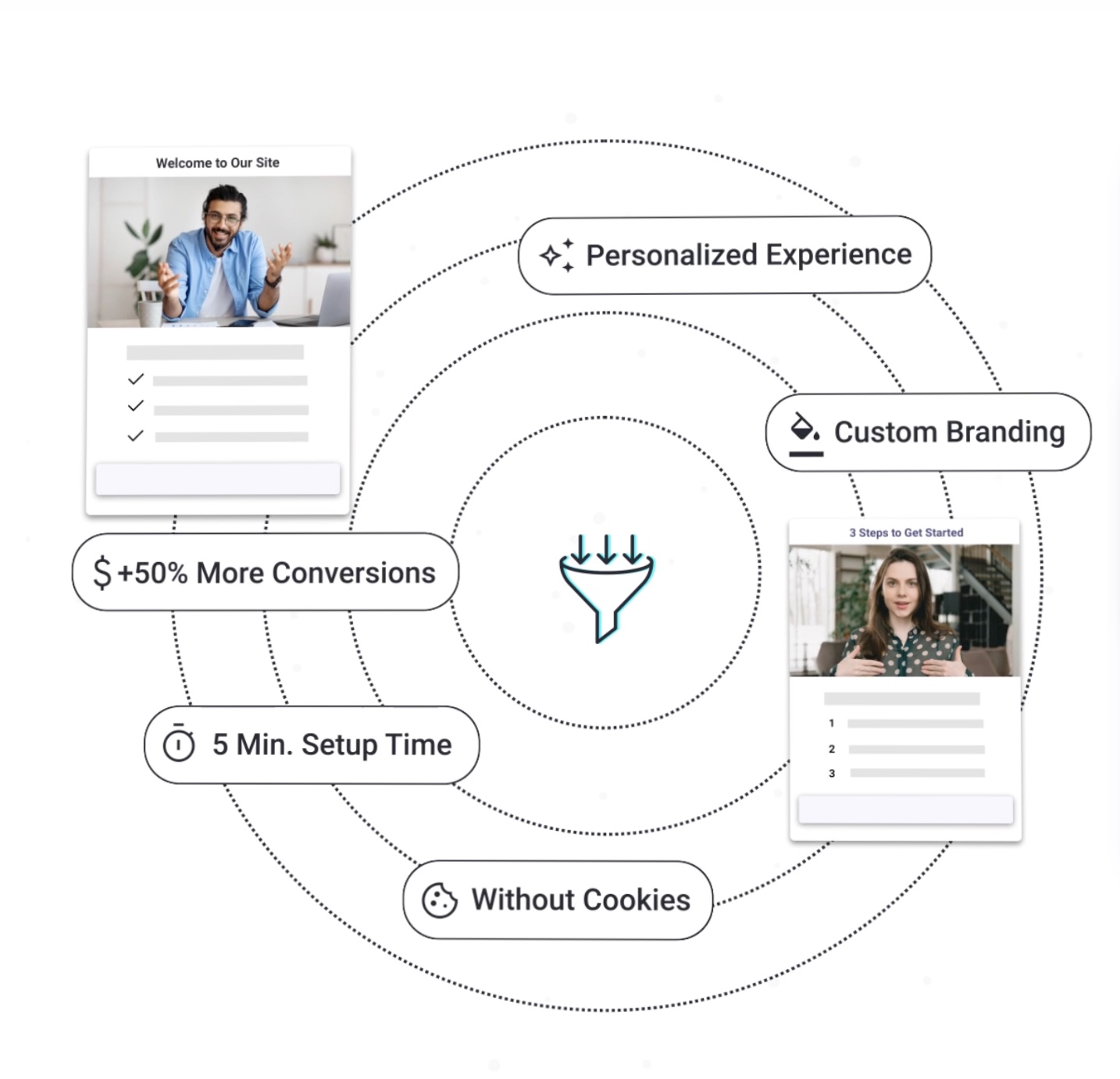
Introduction
In this episode, we welcome Ashok Azhagarasan, head of growth at OSS Ventures, a startup studio and industry accelerator focused on revolutionizing the manufacturing sector.
Ashok discusses their unique model of identifying pain points in factories, developing SaaS solutions, and launching startups to address these challenges. He shares insights on their growth strategies, the importance of sales-driven approaches in the manufacturing industry, and how they’re bridging the gap between strategic and operational levels.
Learn about OSS Ventures’ portfolio of innovative solutions, from workforce planning to energy management, and how they’re driving digital transformation in an industry with only 40% tech maturity.
More Sales From Your Website With AI
Personalized interactions based on your users' behaviour to get +50% more conversions.

Lukas Haensch: Before we get started with today’s episode, let me give you a brief overview of what Pathmonk is all about. Pathmonk is the AI tool for website conversions. With increasing online competition, more than 98% of all website visitors simply don’t convert, right? No matter how much you spend on ads, SEO, or whatever you do, 98% of your visitors simply don’t convert. So, the ability to successfully show them your value proposition and support visitors throughout the buyer’s journey separates you from the competition online. Pathmonk qualifies and converts leads on your website by figuring out where they are in the buying journey and influencing them in key decision moments with relevant micro experiences like case studies, introduction videos, and much more. You can stay relevant to the journey of your visitor fully, automatically run by AI, and increase conversions by 50%. Simply add the JavaScript snippet to your website, let the AI do all the work, and get access to 50% more leads from your website. Check it out on pathmonk.com.
In today’s episode of the Pathmonk Presents podcast, I’ve got a very interesting guest here with me today. I’m with Ashok, who is heading over from the folks at OSS Ventures. They run a super interesting model. They help the manufacturing space basically get up to speed with the latest technology and launch companies into the wild with those providers. I don’t want to take away too much, so Ashok will give us an exact insight into how the model works, how they’re thinking about growth, and how they ultimately help their partners grow their companies. So welcome to the show, Ashok.
Ashok Azhagarasan: Thanks a lot, Lukas.
Lukas: Yeah, sure. So maybe give people an overview—many may not have heard yet about the model that you’re running. So, could you give a quick overview?
Ashok: Sure. So I’m Ashok, the head of growth at OSS Ventures. We have a startup studio in the industry 4.0 space. We’ve launched about 20 startups in the last four years and we are deployed in over 1,000 factories with around 80,000 active users. The way we work is by going into factories, identifying pain points, and seeing whether those pain points can be digitalized with a SaaS solution. Then, we launch the startup. We take about 25% of the company, recruit a CTO and a CEO, and they have the majority stake of 75%. We co-build the startup with them. We have an internal process with capabilities in product, tech, growth, go-to-market, and UX design. We co-build the solution with them. We have a lot of repeatable assets, including around 800 clients we can call on to identify whether there’s a pain point and if they’re willing to pay for the solution. Once we identify the need, we invest half a million in cash, as well as resources, into the startup to co-build the solution with them.
Lukas: Very cool, very clear model. So, how do you find your founders?
Ashok: We have around 8,000 people applying per year, and we shortlist them. We recruit around 20 out of those 8,000 and have a success rate of about 50%.
Lukas: Awesome.
Ashok: We work very closely with them.
Lukas: And do you launch one company a year? What does that look like?
Ashok: We launch about four to five companies a year in the startup studio, and we also invest in two to three each year.
Lukas: Gotcha, makes a lot of sense. So you’re working with those organizations, and you’re the head of growth, correct?
Ashok: Yes, exactly.
Lukas: Very cool. So tell me, what type of channels and growth strategies do you typically apply?
Ashok: In the beginning, we don’t actually have a website or brand presence. We start from scratch, building the website, visuals, and a basic sales deck. We show that to clients, along with a Figma prototype of the startup, and ask whether they’d be willing to co-build and if it interests them. The final step is validating whether they’re willing to pay for it. The idea is to find two or three co-constructors to build the solution with. At the same time, we use outbound channels like cold calling and cold outreach to different market segments to validate that the same problem exists across sectors. We don’t want to build something for just one sector like luxury or aeronautics; instead, we ensure the problem exists in multiple sectors and company sizes—enterprise, SMBs, and family-owned businesses. Then, we build the go-to-market strategy to reach $1 million or 500k and consider content, SEO, and other channels we can test.
Lukas: Got it. What role does the website usually play in those growth strategies? Is the website a key player? Is it content-driven growth or more sales-driven? Tell us more about that.
Ashok: Initially, it’s 100% sales-driven. In the manufacturing industry, people don’t usually search for keywords, so SEO plays a minor role. The actual decision-makers rarely use content; we might push content via email, but it’s heavily sales-driven and cold outreach-based. The manufacturing sector’s digital maturity is only about 40% in Europe, so we need to show them how SaaS solutions work and reassure them that they exist.
Lukas: Very interesting. How did you get into this space? Was it the low digitalization rate that made it attractive, or something else?
Ashok: It’s founder-led. Our founder, Renaud, has eight years of experience in the manufacturing space as a director in the energy sector. He worked in supply chain, factory operations, and strategic roles in the luxury sector. He understood the need for digitalization and tech-enabled solutions. He launched his own startup in AI, which he sold in San Francisco. With experience in both worlds, when he exited, he wanted to invest in manufacturing startups. He noticed that while there were a lot of hardware solutions, there was very little SaaS or software solutions for specific pain points. Often, we’re competing against Excel files, not direct competitors.
Lukas: That’s interesting. Can you give us an example of the types of problems you’re tackling for manufacturers?
Ashok: Sure. One key issue is workforce planning. In white-collar industries, people have clear career paths and training programs, but for blue-collar workers, there’s often no clear skill matrix. Managers rely on memory to know who can operate which machine, and many shop floor workers are nearing retirement. We help companies digitalize this knowledge so that skills are transferable to younger workers. Another example is problem resolution management. In many factories, problems are noted on whiteboards or post-its. We digitalize this process, creating a searchable database so that when the same problem arises six months later, they can easily find the resolution.
Lukas: Got it. So, what’s the minimum size of a manufacturer that would benefit from your solutions?
Ashok: We generally work with companies that have at least 500 employees, up to around 10,000. But we also work with smaller, family-owned businesses, depending on the solution. For example, we built an energy management system specifically for SMBs because larger companies already have those systems in place.
Lukas: Very cool. So, if people head over to the OSS Ventures portfolio, they can see the types of companies you’re building?
Ashok: Exactly.
Lukas: Which one do you personally have the highest confidence in?
Ashok: It depends. All of our companies have validated market needs, but some are more mature than others. Companies we built four years ago are now 8,000-person businesses with strong market validation, while newer companies are still building recognition.
Lukas: Very cool. Let’s switch gears a bit and talk about your day-to-day. How does a typical day look for you?
Ashok: I split my time between marketing actions for OSS Ventures and supporting two to three startups. It’s about 25% for each, and it depends on the week. We also help our portfolio startups with strategy and growth challenges.
Lukas: Awesome. Now, for some rapid-fire questions—are you ready?
Ashok: Sure!
Lukas: What’s the last book you read?
Ashok: Built to Last.
Lukas: What’s the single thing your company is most focused on at the moment?
Ashok: Being customer-centric and becoming a financial institution.
Lukas: If there were no tech boundaries, what’s the one thing you’d fix for your role as a marketer?
Ashok: Structuring data and getting rid of Excel.
Lukas: And finally, if today were your first day at OSS Ventures, what advice would you give yourself?
Ashok: Go to factories, talk to customers, and gather as much information as possible before thinking about anything else.
Lukas: Great advice! For those interested, where are your solutions being used—are we talking Europe, the US, the UK?
Ashok: We’re about 40% in Europe and 60% globally. We’ve deployed in 47 countries across 2,000 factories.
Lukas: Awesome! Ashok, thank you so much for your time and for sharing insights into OSS Ventures. It’s been a pleasure.
Ashok: Thank you so much, Lukas! It was a pleasure.











